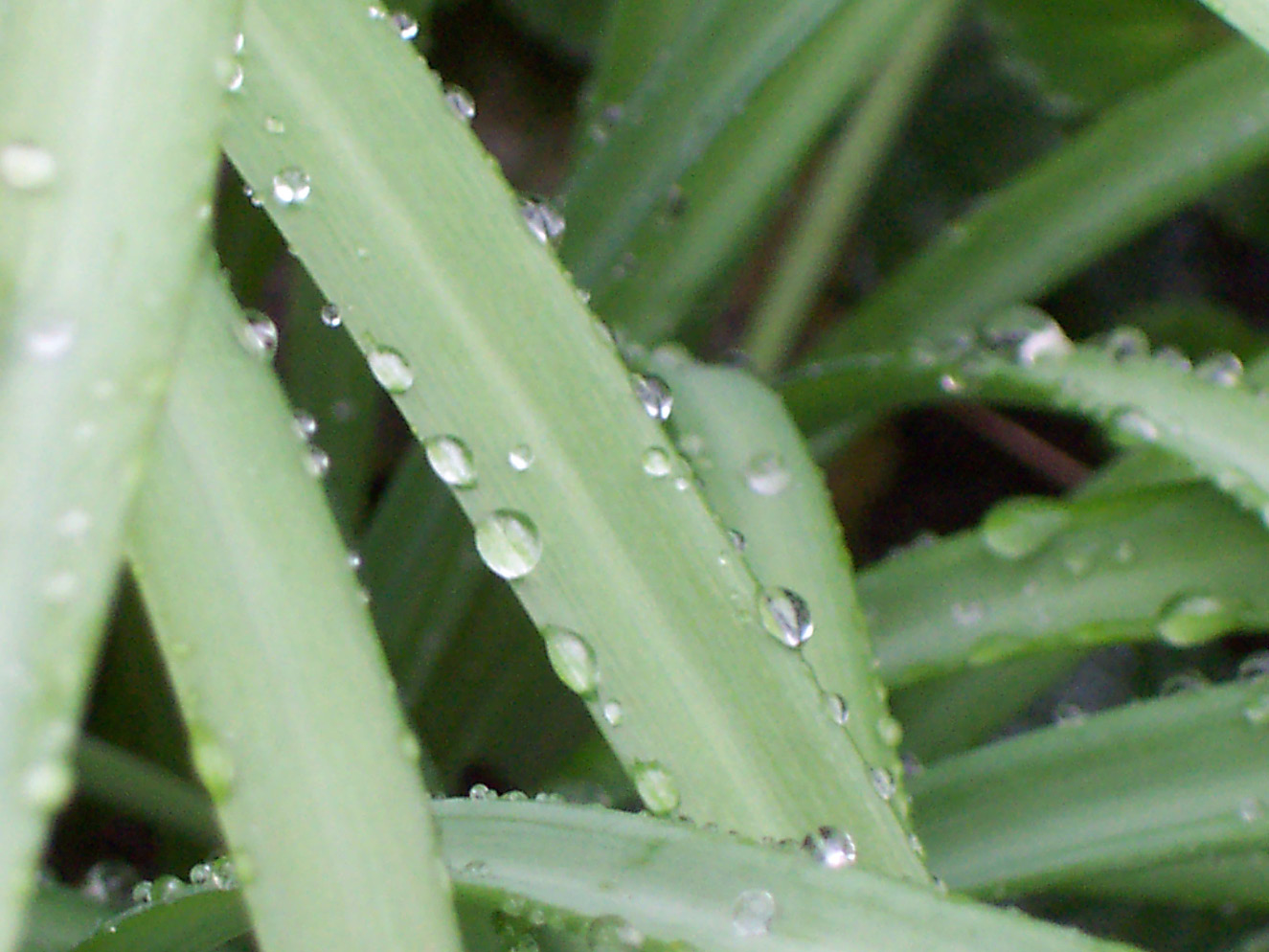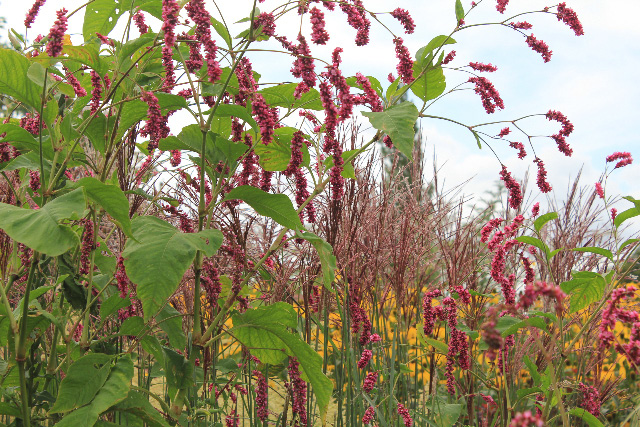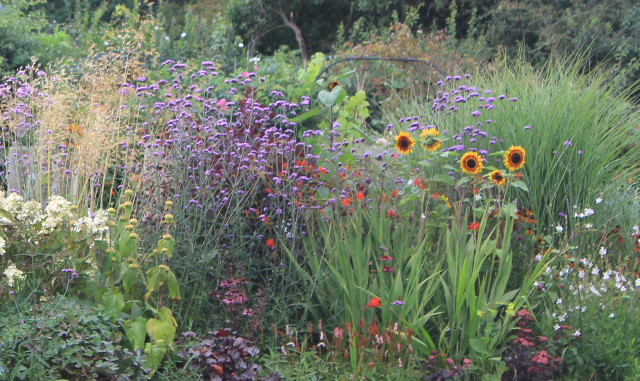It won’t have escaped your notice that the quality of the light changes at this time of the year – it’s now softer, more golden and the sun hangs lower in the sky, shining through the plants rather than at them. This shift in the position of the sun heralds many changes in the garden affecting the way we look at plants and especially ornamental grasses. On the other side of the summer when the grasses were greener, they brought movement and a tactile delicacy to the border. Back then they were overshadowed by the other plants, but now they’re tawny, tinged with pink or burgundy and touched by the magical early autumn light. This is the perfect moment for ornamental grasses to step out onto the stage and steal the show.
Designing with grasses
For a contemporary look – plant grasses in fairly large groups for the classic ‘prairie’ style of planting and then intersperse with drifts of late summer perennials like echinacea, aster and persicaria. This sort of border needs to be on a big scale in order to show the plants off to best effect. The well known designer Piet Oudolf has made this style of gardening very popular and it is a good way to cover a large space in an interesting way. Not many of us own gardens as large as a park, but grasses can still look good in smaller quantities, and even classic planting schemes can be enhanced by a few dancing grasses in among the traditional plants. They bring movement and light and can lift the whole border, especially when placed in amongst static, chunky plants like phlox, sedum or some of the more clumpy geraniums. You can even use the taller, more substantial grasses like miscanthus in place of shrubs. They take up about as much space, and grow more quickly. Grass doesn’t have the stodgy ‘pudding’ look that many shrubs are weighed down by either.
Three seasons of interest – this is where grasses have it over many other plants; they can look good for most of the year – and their ‘off’ season happens to be just when the rest of the plants are looking good. In the spring it’s easy to divert attention elsewhere while the grasses grow some new clothes. You can avoid the bare stumpy look by growing early season plants, such as poppies and bulbs among your grasses. Growth is strong and fast in the spring too, so it won’t take long before they shoot up and look less unsightly.
Getting the best from them
Cultivation – most grasses prefer an open, sunny situation, but will tolerate a range of soils. They come from meadow environments and situations where competition with other plants is strong, so they’re usually tough and will grow in among other plants well. Don’t overfeed them though, as this encourages more leaf than flower.
Pruning – grasses are either evergreen or deciduous and those that die off in the winter need to be cut back in early spring before any new growth starts. Grass grows fast in the spring and it’s easy to end up with a tangle of old and new growth. Cut back as hard as you can – aim for a ‘balding hedgehog’ look, so that the new shoots can come through the old growth cleanly. Evergreen plants like stipas can be tidied up in the spring with a rake through to dislodge the old foliage, then every couple of years you can give them the short back and sides treatment and have a good tidy up.
Propagation – grasses are clump forming and can be lifted and divided in the spring if they start getting too large.
Tall
Calamagrostis ‘Karl Foerster’ is my absolute favourite medium/tall grass. Like most it starts slowly and goes unnoticed for much of the year, then flowers in the quiet way that grasses do, demurely unfurling its purple-tinged feathery heads. These gradually become tawny and then a paler gold, but the great thing about this grass is that it stands so upright, tall and slender, never really getting above itself and most importantly, not blowing over in the wind. It will last right through the winter like this, making a straw coloured stand through the worst of the weather.
Stipa gigantea (Golden Oat grass) is another tall grass, this one making a basal clump of growth (that can get quite big) and then, earlier than most of the other grasses, sending up golden, ‘oaty’ seedheads that look fantastic planted somewhere where the light can shine through it. It makes a great companion to Verbena bonariensis.
Miscanthus sinensis can be a bit of a thug, but very useful at the back of a border or in place of a shrub. The striped M. zebrinus is a striking variety and less bulky. All miscanthus have soft maroon plumes that last through the autumn and into the winter. Cut back hard in early spring.
Medium
Pennisetum setaceum ‘Rubrum’, or Purple Fountain grass, will grow comfortably in a container and looks good as a specimen with its dark leaves and fluffy plumes, but it’s not always reliably hardy, so a safer bet would be the slightly less spectacular Pennisetum alopecuroides.
Panicum virgatum ‘Rubrum’ – a clump forming, fairly upright grass that comes into its own in autumn and winter, providing structure and holding its shape well.
Low growing
Stipa tenuissima – I love this irresistibly tactile plant. It can be used in almost any planting scheme and provides welcome movement and contrast.
Carex elata (‘Bowles Golden Grass’) – one of the few grasses that will grow in a shady situation, where its lime green leaves light up and provide a good foil for other plants.
Festuca glauca ‘Elijah Blue’ – this is a useful little grass for autumnal container displays; the glaucous blue/green of the leaves contrast well with russety tones and dumpy plants like chrysanthemums, low growing asters and pansies.
As the sunshine in the garden softens and turns gold this month, let’s try not to mourn the end of summer, but welcome in the change of season. The summer days may be numbered, but there’s no reason for the garden to stop just yet, in fact many of the late summer perennials that go so well with grasses are just coming into their prime. Let’s go all Piet Oudolf and plant a prairie.
TEST
Grasses can look good for most of the year – and their ‘off’ season happens to be just when the rest of the plants are looking good
TEST
You can avoid the bare stumpy look by growing early season plants, such as poppies and bulbs among your grasses
- words: Jo Arnell
You may also like
In the Night Garden
Jo Arnell explains how to make the most of your outdoor space once darkness falls Some enchanted evening you may see me outside – mainly searching for slugs in the garden, because the cool hours of night are when they...
Contain your excitement
Jen Stuart-Smith discusses how to get creative with your pots and planters My love affair with plants started with houseplants when I was a child. As my bedroom windowsill overflowed – resulting, occasionally, in waking up with compost under my...
More than just a pretty face
Jen Stuart-Smith explores the multiple uses of some easy-to-grow garden favourites When you grow flowers for their beauty, shape and colour it can be easy to forget all the other qualities they have to offer. Some are edible, others provide...










